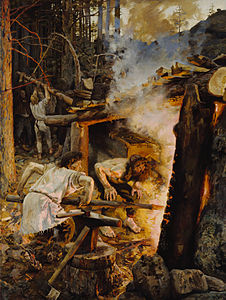
The Kalevala is a 19th-century compilation of epic poetry, compiled by Elias Lönnrot from Karelian and Finnish oral folklore and mythology, telling an epic story about the Creation of the Earth, describing the controversies and retaliatory voyages between the peoples of the land of Kalevala called Väinölä and the land of Pohjola and their various protagonists and antagonists, as well as the construction and robbery of the epic mythical wealth-making machine Sampo.

Akseli Gallen-Kallela was a Finnish painter who is best known for his illustrations of the Kalevala, the Finnish national epic. His work is considered a very important aspect of the Finnish national identity. He finnicized his name from Gallén to Gallen-Kallela in 1907.
Finnish mythology commonly refers of the folklore of Finnish paganism, of which a modern revival is practiced by a small percentage of the Finnish people. It has many shared features with Estonian and other Finnic mythologies, but also with neighbouring Baltic, Slavic and, to a lesser extent, Norse mythologies.

Kullervo is an ill-fated character in the Kalevala, the Finnish national epic compiled by Elias Lönnrot.

Ilmarinen, a blacksmith and inventor in the Kalevala, is a god and archetypal artificer from Finnish mythology. He is immortal and capable of creating practically anything. In addition, he is described as working the known metals of the time, including brass, copper, iron, gold, and silver. The great works of Ilmarinen include the crafting of the dome of the sky and the forging of the Sampo. His usual epithet in the Kalevala is seppä or seppo ("smith"), which is the source of the given name Seppo.

Väinämöinen is a demigod, hero and the central character in Finnish folklore and the main character in the national epic Kalevala by Elias Lönnrot. Väinämöinen was described as an old and wise man, and he possessed a potent, magical singing voice.
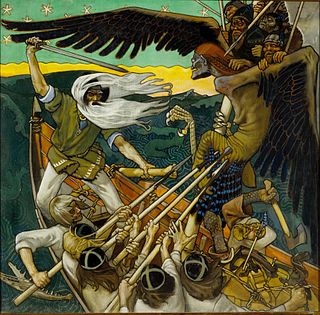
Louhi is a wicked queen of the land known as Pohjola in Finnish mythology and a villain of the Kalevala. As many mythological creatures and objects are easily conflated and separated in Finnish mythology, Louhi is probably an alter-ego of the goddess Loviatar.

Pohjola, sometimes just Pohja, is a location in Finnish mythology. It is one of the two main polarities in the Finnish national epic, the Kalevala, along with Kalevala or Väinölä.

Lemminkäinen or Lemminki is a prominent figure in Finnish mythology. He is one of the heroes of the Kalevala, where his character is a composite of several separate heroes of oral poetry. He is usually depicted as young and good-looking, with wavy red hair.
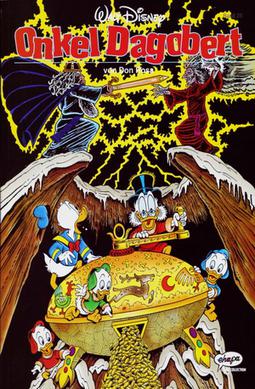
"The Quest for Kalevala" is a 1999 Uncle Scrooge comic book story written and drawn by Don Rosa. The story was first published in the Danish Anders And & Co. #1999-48; the first American publication was in Uncle Scrooge #334, in October 2004.

Joukahainen is a character in the Kalevala, the Finnish epic poem. He is a rival of the main character, Väinämöinen.

Aino is a figure in the Finnish national epic Kalevala.

Sampo is a 1959 Soviet–Finnish fantasy film based loosely on the events depicted in the Finnish national epic Kalevala. In the United States, it was released in an edited version, The Day the Earth Froze, by American International Pictures as a double feature with Conquered City. This version was later featured in a 1993 episode of Mystery Science Theater 3000.
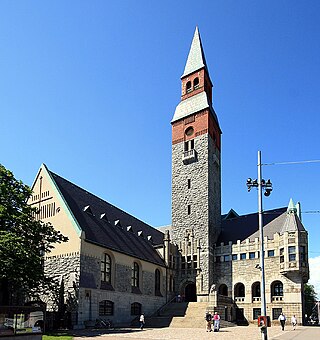
The National Museum of Finland is a museum in Helsinki presenting Finnish history from the Stone Age to the present day, through objects and cultural history. The Finnish National Romantic style building is located at Mannerheimintie 34 in central Helsinki and is a part of the Finnish Heritage Agency, under the Ministry of Culture and Education.
This is a summary of the cantos of the Kalevala.

The Old Student House is the former student house of the Student Union of the University of Helsinki, located in central Helsinki, Finland, near the crossing of Aleksanterinkatu and Mannerheimintie.

The Defense of the Sampo is a tempera-on-canvas Romantic national painting created in 1896 by Finnish painter Akseli Gallen-Kallela. The painting illustrates a passage from the Kalevala, the Finnish national epic compiled by Elias Lönnrot in the 19th century.

Lemminkäinen's Mother is an 1897 Romantic nationalist painting by Finnish painter Akseli Gallen-Kallela. The painting illustrates a passage from the Kalevala, the Finnish national epic compiled by Elias Lönnrot in the 19th century.
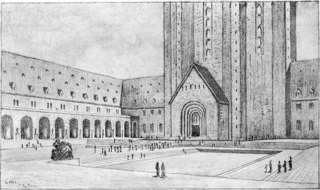
The Kalevala House was a proposed monumental building in Helsinki, Finland, intended to serve as the headquarters of the Kalevala Society and a center of Finnish culture. The plans included a Finnish cultural research institute, exhibition spaces, artists' workspaces and "research chambers". Additionally, the crypt beneath the foot of the 80-meter-high main tower was to serve as a burial place for notable Finnish figures and Fennomen. The building was to be located at the top of Munkkiniemi, near the present-day Hotel Kalastajatorppa.

Kalevala: The New Era is a 2013 Finnish fantasy film directed by Jari Halonen. It loosely based on Finnish epic poetry, The Kalevala, taking place both in the ancient land of the Kalevala and also in modern Finland.



